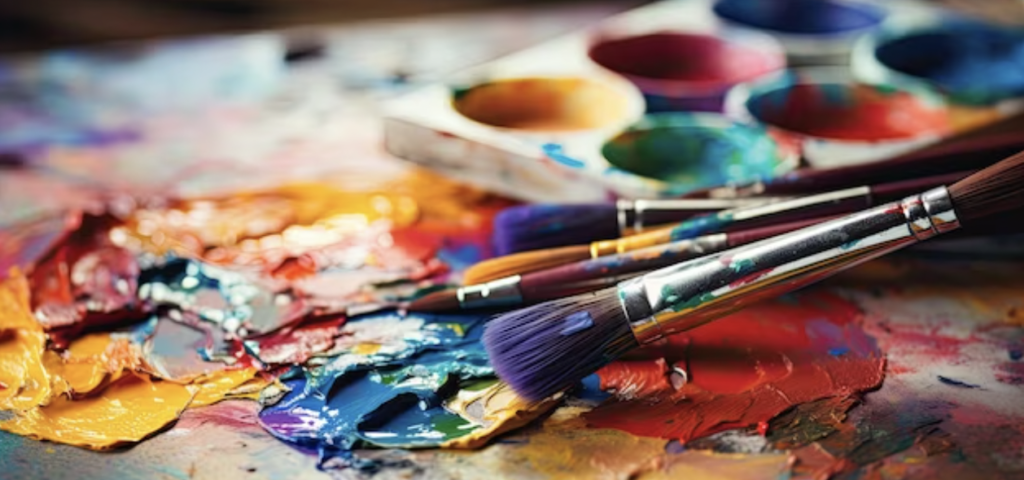The Best Type of Paint Brushes for Acrylic: All Skill Levels

Acrylic painting is a versatile and exciting medium for artists of all skill levels. However, choosing the right paint brushes can make a significant difference in your creative process and the quality of your artwork. In this comprehensive guide, we’ll explore the best types of paint brushes for acrylic painting. We’ll discuss various brush shapes, sizes, and bristle materials to help you make informed choices and enhance your acrylic painting experience.
Understanding Acrylic Paint
Before delving into the world of paint brushes, let’s briefly explore acrylic paint. Acrylic paint is known for its quick drying time, versatility, and ability to be used on various surfaces. It offers vibrant, long-lasting colors and can be thinned with water or acrylic mediums to achieve different effects, from translucent glazes to thick impasto textures.
The Importance of Choosing the Right Brushes
Selecting the right brushes for acrylic painting is essential. Different brush types are designed for specific applications, and using the wrong brush can hinder your creative process. The choice of brush affects your ability to achieve fine details, smooth blends, textured strokes, and other artistic techniques.
Types of Acrylic Paint Brushes
- Round Brushes: Round brushes are versatile and suitable for various applications. They have a pointed tip, which allows for fine lines and details. Round brushes can be used for both controlled strokes and broader, looser applications.
- Flat Brushes: Flat brushes have a squared-off, flat tip, which makes them ideal for covering large areas and creating sharp edges. They are great for creating clean lines and even layers.
- Filbert Brushes: Filbert brushes have a flat, oval-shaped tip, combining the characteristics of both flat and round brushes. They are excellent for blending, soft edges, and achieving organic shapes.
- Bright Brushes: Bright brushes have shorter bristles than flat brushes, which provide more control and are perfect for bold strokes and impasto techniques.
- Fan Brushes: Fan brushes have bristles spread out in a fan shape, making them suitable for creating textures, blending, and special effects like foliage in landscape painting.
- Angle Brushes: Angle brushes have a slanted tip, making them ideal for precise strokes, detailed work, and creating sharp lines or curves.
- Liner Brushes: Liner brushes have long, thin bristles that are excellent for fine lines, intricate details, and calligraphy-style strokes.
Brush Sizes
Brush sizes vary from very fine to very large, indicated by numbers. Smaller numbers represent larger brushes. When choosing the appropriate brush size, consider the scale of your artwork and the level of detail you want to achieve. Smaller brushes are suitable for fine details, while larger brushes are better for covering larger areas.
Bristle Materials
The bristle material of a brush affects its durability, texture, and performance with acrylic paint. Here are the most common bristle materials for acrylic brushes:
- Nylon: Nylon brushes are durable, easy to clean, and affordable. They work well with acrylic paint, especially for beginners. They are available in a variety of shapes and sizes.
- Natural Bristles: Natural bristle brushes are typically made from animal hair, such as hog bristle. They are great for heavy body acrylics and impasto techniques, as they can hold a lot of paint. However, they are not suitable for water-based acrylics, as they may become soft and lose their shape.
- Synthetic Bristles: Synthetic brushes are versatile and suitable for all types of acrylic paint. They are durable, maintain their shape, and are easy to clean. Many artists prefer synthetic brushes for acrylic painting, as they offer a good balance between affordability and performance.
- Blended Bristles: Some brushes combine synthetic and natural bristles to provide the benefits of both. They can be suitable for various painting techniques.
Tips for Choosing the Right Brushes
- Consider Your Painting Style: Your choice of brushes should align with your painting style and the techniques you frequently use. If you paint with a lot of detail, invest in fine, pointed brushes. If you prefer broad, sweeping strokes, choose larger flat or bright brushes.
- Quality Matters: While budget brushes can be suitable for beginners, investing in high-quality brushes can significantly improve your painting experience. Quality brushes maintain their shape, hold more paint, and offer better control.
- Test Before You Buy: If possible, visit an art supply store to feel the brushes and test them out. This hands-on experience can help you choose the brushes that feel most comfortable and suitable for your needs.
- Maintain and Clean Your Brushes: Proper care and cleaning of your brushes will extend their lifespan and ensure consistent performance. Wash them with water and mild soap or acrylic brush cleaner after each use. Shape the bristles and let them air dry.
- Experiment and Learn: Don’t be afraid to experiment with different brush shapes, sizes, and materials. Over time, you’ll discover which brushes work best for your unique artistic style.
Selecting the right paint brushes for acrylic painting is a vital step in your artistic journey. The type of brush, size, and bristle material you choose can greatly influence your ability to express your creativity and achieve the desired results in your artwork. By understanding the various options available and considering your own preferences and techniques, you can make informed choices and elevate your acrylic painting experience. Whether you’re a beginner or an experienced artist, the right brushes will be your trusted companions on your artistic voyage.
You should be a part of a contest for one of the most useful websites on the web. I am going to recommend this website!